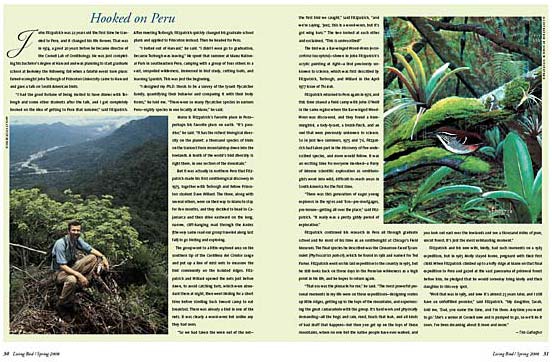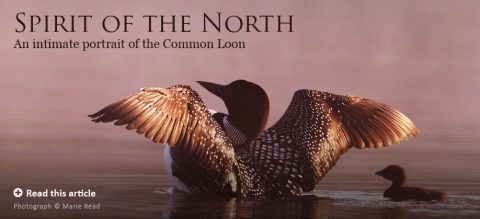Hooked on Peru: Lab Director John Fitzpatrick’s Early Career in the Tropics
By Tim Gallagher April 15, 2008

John Fitzpatrick was 22 years old the first time he traveled to Peru, and it changed his life forever. That was in 1974, a good 20 years before he became director of the Cornell Lab of Ornithology. He was just completing his bachelor’s degree at Harvard and was planning to start graduate school at Berkeley the following fall when a fateful event took place: famed ecologist John Terborgh of Princeton University came to Harvard and gave a talk on South American birds.
“I had the good fortune of being invited to have dinner with Terborgh and some other students after the talk, and I got completely hooked on the idea of getting to Peru that summer,” said Fitzpatrick. After meeting Terborgh, Fitzpatrick quickly changed his graduate school plans and applied to Princeton instead. Then he headed for Peru.
“I bolted out of Harvard,” he said. “I didn’t even go to graduation, because Terborgh was leaving.” He spent that summer at Manu National Park in southeastern Peru, camping with a group of four others in a vast, unspoiled wilderness, immersed in bird study, cutting trails, and learning Spanish. This was just the beginning.
“I designed my Ph.D. thesis to be a survey of the tyrant flycatcher family, quantifying their behavior and comparing it with their body forms,” he told me. “There were so many flycatcher species in eastern Peru—eighty species in one locality at Manu,” he said.
Manu is Fitzpatrick’s favorite place in Peru—perhaps his favorite place on earth. “It’s paradise,” he said. “It has the richest biological diversity on the planet: a thousand species of birds on the transect from mountaintop down into the lowlands. A tenth of the world’s bird diversity is right there, in one section of the mountain.”
But it was actually in northern Peru that Fitzpatrick made his first ornithological discovery in 1975, together with Terborgh and fellow Prince-ton student Dave Willard. The three, along with several others, were on their way to Manu to stay for five months, and they decided to head to Cajamarca and then drive eastward on the long, narrow, cliff-hanging road through the Andes (the very same road our group traveled along last fall) to go birding and exploring.
The group went to a little-explored area on the southern tip of the Cordillera del Cóndor range and put up a line of mist nets to measure the bird community on the isolated ridges. Fitzpatrick and Willard opened the nets just before dawn, to avoid catching bats, which were abundant there at night, then went birding for a short time before strolling back toward camp to eat breakfast. There was already a bird in one of the nets. It was clearly a wood-wren but unlike any they had seen.
“So we had taken the wren out of the net—the first bird we caught,” said Fitzpatrick, “and we’re saying, ‘Jeez, this is a wood-wren, but it’s got wing bars.’” The two looked at each other and exclaimed, “This is undescribed!”
The bird was a Bar-winged Wood-Wren (Henicorhina leucoptera)—shown in John Fitzpatrick’s acrylic painting at right—a bird previously unknown to science, which was first described by Fitzpatrick, Terborgh, and Willard in the April 1977 issue of The Auk.
Fitzpatrick returned to Peru again in 1976, and this time shared a field camp with John O’Neill in the same region where the Bar-winged Wood-Wren was discovered, and they found a hummingbird, a tody-tyrant, a brush-finch, and an owl that were previously unknown to science. So in just two summers, 1975 and ’76, Fitzpatrick had taken part in the discovery of five undescribed species, and more would follow. It was an exciting time for everyone involved—a flurry of intense scientific exploration as ornithologists went into wild, difficult-to-reach areas in South America for the first time.
“There was this generation of eager young explorers in the 1970s and ’80s—pre-mortgages, pre-tenure—getting all over the place,” said Fitzpatrick. “It really was a pretty giddy period of exploration.”
Fitzpatrick continued his research in Peru all through graduate school and for most of his time as an ornithologist at Chicago’s Field Museum. The final species he described was the Cinnamon-faced Tyrannulet (Phylloscartes parkeri), which he found in 1981 and named for Ted Parker. Fitzpatrick went on his last expedition to the country in 1985, but he still looks back on those days in the Peruvian wilderness as a high point in his life, and he hopes to return again.
“That era was the pinnacle for me,” he said. “The most powerful personal moments in my life were on those expeditions—designing routes up little ridges, getting up to the tops of the mountains, and experiencing the great camaraderie with the group. It’s hard work and physically demanding—all the bugs and rain, mud, boats that leak, and all kinds of bad stuff that happens—but then you get up on the tops of these mountains, where no one but the native people have ever walked, and you look out east over the lowlands and see a thousand miles of pure, uncut forest. It’s just the most exhilarating moment.”
Fitzpatrick and his new wife, Molly, had such moments on a 1983 expedition, but in 1985 Molly stayed home, pregnant with their first child. When Fitzpatrick climbed up to a lofty ridge at Manu on that final expedition to Peru and gazed at the vast panorama of primeval forest before him, he pledged that he would someday bring Molly and their daughter to this very spot.
“Well that was in 1985, and now it’s almost 23 years later, and I still have an unfulfilled promise,” said Fitzpatrick. “My daughter, Sarah, told me, ‘Dad, you name the time, and I’m there. Anytime you want to go.’ She’s a senior at Cornell now and is pumped to go, so we’ll do it soon. I’ve been dreaming about it more and more.”


All About Birds is a free resource
Available for everyone,
funded by donors like you





